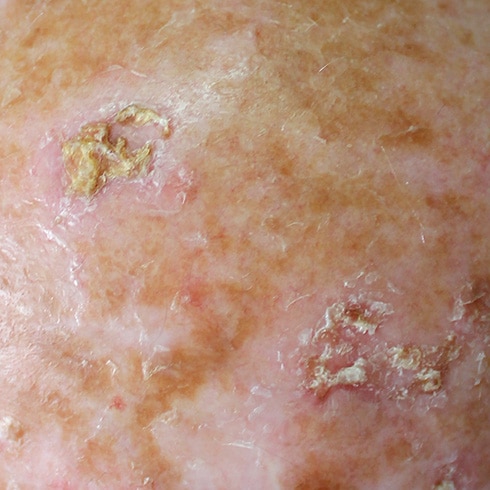What is Actinic Keratosis?
Actinic keratosis is a scaly, rough patch of skin that is caused by prolonged exposure to the sun. They can often be found on the face, lips, ears, scalp, neck, or the back of the hands, as these areas are often exposed to sunlight. These patches grow slowly and usually appear in people over 40 years old. If left untreated, actinic keratosis can turn into squamous cell carcinoma, a form of skin cancer.
Actinic keratoses can vary in appearance. Common signs include:
- Dry, rough, or scaly patch of skin.
- Flat or slightly raised patch or bump on the top layer of skin.
- Pink, red, or brown coloring.
- Burning, itching, crusting, or bleeding.
- New bumps or patches forming on sun-exposed areas.
Individuals with red or blonde hair and light skin, have a history of sunburn, are older than 40, live in a sunny place, work outside, or have a weakened immune system may be at a higher risk for developing actinic keratosis.
Actinic Keratosis Treatment
Sometimes, an actinic keratosis will disappear on its own but may return when the area is exposed to the sun. Because it is difficult to determine when an actinic keratosis will develop into skin cancer, they are usually removed as a precautionary measure. Treatment options include:
Medications
A medicated cream or gel can be prescribed to remove actinic keratoses, such as fluorouracil, imiquimod, ingenol mebutate, or diclofenac. These products may cause scaling, redness, or a burning sensation for a couple of weeks.
Surgery and Other Procedures
- Cryosurgery: During this treatment, liquid nitrogen is used to remove the actinic keratosis. As your skin heals, the damaged cells will fall off, revealing new skin to appear.
- Curettage: This involves the use of a special device called a curet to scrape away damaged cells. Local anesthesia is used, and side effects may include changes in skin color or scarring.
- Photodynamic Therapy: A light-sensitive chemical solution is applied to the affected area. A special light is then shone on the area to destroy the actinic keratosis. Side effects include swelling, redness, and a burning sensation.
Following actinic keratosis treatment, patients are suggested to see a dermatologist for a skin check yearly to ensure they do not have skin cancer.
Actinic Keratosis FAQS
Can actinic keratosis turn into cancer?
Can actinic keratosis turn into basal cell carcinoma?
Do chemical peels help actinic keratosis?
Does actinic keratosis need to be removed?
Does Retin A help actinic keratosis?
How can you tell the difference between actinic keratosis and seborrheic keratosis?
How do you treat actinic keratosis on the face?
How is actinic keratosis prevented?
Is actinic keratosis dangerous?
Should actinic keratosis be biopsied?
What causes keratosis?
What does actinic keratosis look like?
What essential oils are good for actinic keratosis?
What is the best treatment for actinic keratosis?
What is the primary cause of actinic keratosis?
Why does actinic keratosis itch?
Candidates for Actinic Keratosis Treatment
Sometimes, it can be difficult to tell between noncancerous and cancerous spots on the skin. If you notice any changes in your skin over time, be sure to see a dermatologist for a skin exam. If you have been diagnosed with actinic keratosis or have any of the symptoms listed above, you should see Dr. Erwin for a skin assessment for a proper diagnosis and treatment.
Contact Us Today
If you are interested in learning more about actinic keratosis or would like treatment, contact our office by calling 979-543-9933 to schedule your consultation appointment with Dr. Erwin.

